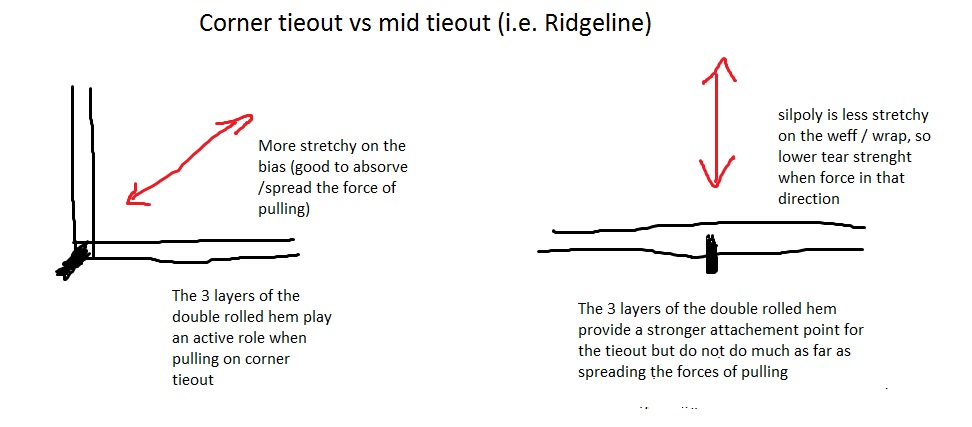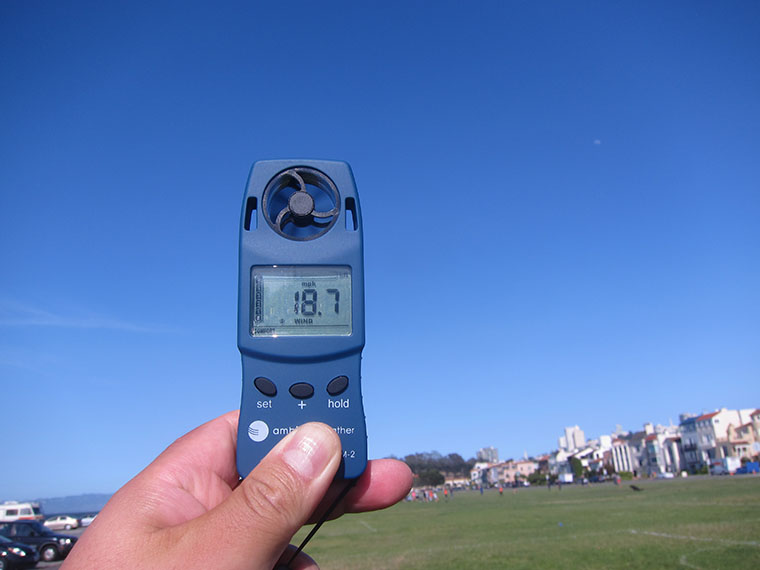Topic
Reinforcing 0.93 osy Membrane silpoly
Forum Posting
A Membership is required to post in the forums. Login or become a member to post in the member forums!
Home › Forums › Gear Forums › Make Your Own Gear › Reinforcing 0.93 osy Membrane silpoly
- This topic has 15 replies, 9 voices, and was last updated 7 years, 10 months ago by
 Jesse Anderson.
Jesse Anderson.
-
AuthorPosts
-
May 23, 2016 at 5:22 pm #3404335
After reading about the stitch elongation Hoosier was seeing with the 0.93 osy Membrane silpoly in another thread (and talking to Hoosier offline), I wanted to show some results and suggestions for reinforcement patches.
Based on Hoosier’s success with radial reinforcement using the same material, I tested a 4″ radial patch – bonded with sil-net and unsewn around the perimeter. Here are some pics:




We’ve got a printer in-house, so I made up a little template in lieu of the coffee can. Makes it simple to cut out patches regardless of the tie-out shape. Applied a thin layer of sil-net to the patch, put down, then let cure overnight with some weight on top. Should be noted that I also cut the reinforcement patches in the approximate same direction as the intended force on the base tarp material to match the stretch (pic 3 above).
For testing, I vertically stitched on the 1/2″ grosgrain tie-out and then tested with 50 lbs. For extra stress, I lifted and dropped the whole thing ~2 ft. Inspected everything after and saw no evidence of stitch elongation at the grosgrain stitching or around the tie-out. Repeated a couple more times with the same result. I then made a horizontal stitch on the grosgrain tie-out and retested. Still looked good. Some pics of the test setup and close-ups of the tie-out after testing:



I also tested without reinforcements (just 1/2″ gg) under the same conditions. No catastrophic failure, but definitely some stitch elongation near the outermost stitch line on the grosgrain. No bueno. Here’s a pic of that:

Overall the silnet bonded radial reinforcement approach seemed to work very well. I don’t know if there’s an accurate way to convert wind speed to ~force on a tie-out, but I would think the wind would need to be pretty strong to produce a force that would cause this tie-out to snap. Of course there’s also the force of tension due to the pitch and that’s going to vary depending on the design or shelter type, but hopefully this gives a point of reference.
I’m going to try and rig up a way to add additional weight and test to failure. I’d like to do the same with Membrane silpoly PU4000. Will report back when I’ve got something on that front.
May 23, 2016 at 6:54 pm #3404350Thanks for doing this testing Kyle. It would be interesting to do the same testing for what would be a tieout of the ridgeline. (where the direction of the pull is on the wrap/weff, rather than in the bias). The dynamics on a corner tieout may be quite different than the one for a ridgeline.
Also for the fabrics that have mixed coatings (sil in one side and PU in the other) like silpoly PU 4000, it would be interesting to see if there is any difference of in which side the reinforcement goes (obviously using a different adhesive: Silnet for sil side or seamgrip fro PU side).
Thanks for your continued effort to provide more options to the DIY market.
 May 23, 2016 at 8:14 pm #3404366
May 23, 2016 at 8:14 pm #3404366Np and I agree a side/ridgeline tie-out test would be a good next step. I’ll see what I can put together tomorrow.
May 23, 2016 at 8:21 pm #3404368Awesome stuff – thanks Kyle! Definitely boosts my confidence for using 0.9 membrane for future projects.
-K
May 24, 2016 at 7:35 am #3404435FWIW, and while I haven’t had my tarp out in high winds, the tie outs are rock solid after numerous pitches since making this modification. This is the way to go and with this method, I fully trust the Membrane fabric as the roof over my head. Thanks for the continued testing and development, Kyle.
May 24, 2016 at 9:57 am #3404462Kyle B said “.. I don’t know if there’s an accurate way to convert wind speed to ~force on a tie-out,”.
I would love to know the answer to this question too. This would be an interesting article for BPL to produce. How much tension there is on the tieouts under different tarp configurations (the most used i.e a-fram, half pyramid, lean-to, etc)
I have done a bit of testing myself, and I had my hoodless tarp-poncho (5’x9.5′) pitched in half pyramid configuration on a day with 18-20 mph winds. I measured 32-35 lb of tension at the apex of the half pyramid and 10-15lbs on the corner tieouts.

 May 24, 2016 at 10:22 am #3404465
May 24, 2016 at 10:22 am #3404465Thank you Kyle!
A pyramid is next on the list after I get my quilt built. I’d love to use this material but was wondering if it would be strong enough for a large 9×9-10×10 pyramid. These tests certainly look promising!
May 24, 2016 at 1:51 pm #3404500If you get a good tensile tester rig going, I’d love to see a comparison of different shapes and (especially) sizes of reinforcements. Would a 2″ radius semi-circle do the job just as well?
The weight savings wouldn’t be significant, but smaller reinforcements are easier to make from scraps.
May 24, 2016 at 1:57 pm #3404502Yeah I imagine a smaller radius would do. I certainly think you could do 3″ if you move the patch away from the corner enough so that you aren’t rolling the patch and base material. I took up about an inch in the hems here since the patch was placed all the way into the corner.
May 24, 2016 at 2:00 pm #3404503By the way, for those who want to print out similar paper templates, I found a nice website for it here. You can set the circle diameter and it will print a 360º protractor at that size.
Jun 5, 2016 at 10:11 pm #3407299Have done some testing with bonding the Membrane PU 2000 coated fabric.
For the Sil coated sides, GE sil glue worked best, but still peeled off fairly easily.
I suspect that the bond would creep with use.For the PU sides, bonded with SeamGrip, and was pleasantly surprised to see that it was almost unpeelable. A very solid bond.
It can be a little difficult to ID the PU sides. Will mark the material before cutting.
This also limits bonding to only one side of the fabric, which can be overcome with some planning and care. With the SeamGrip, reinforcement patches will need no stitching, except where loops and sleeves are attached.Only regret is the wish for a thinner (lower viscosity) adhesive than Seam Grip.
Will look around and experiment with thinning the SeamGrip. Not really keen on the 2-part PU adhesives, and definitely ordinary PU adhesives that foam when drying. Did use clamps along with a roller due to the thickness of the SeamGrip.Any thoughts on which side should face out (toward the weather)?
Jun 6, 2016 at 7:19 am #3407328Sam, I also have had good results with SeamGrip and Silpoly PU 4000. You can lower SeamGrip’s viscosity by adding Cotol which is a curing ascelerator. I have not noticed any negative effects on the bonding strength by using it. You can buy seamgrip with Cotol in a combined package or cotol on it own.
Jun 6, 2016 at 8:29 am #3407340nice testing!
There was an article about stake holding power https://backpackinglight.com/tent_stakes/
Most stakes held less than 50 pounds before pulling out. Some almost to 70 pounds (y stakes, groundhog, 9 inch long stakes). Nail stakes only 40 pounds.
One could argue that the tent should withstand a higher force, so that the stake will pull out before the tent rips. So maybe 50 pounds is a bit low for your test, but that’s pretty good.
Jun 6, 2016 at 9:47 am #3407352I wonder if a 2 inch circle would be just as good? All it has to do is go 1/2 inch or 1 inch beyond the grosgrain? Probably insignificant weight savings.
Maybe the circular shape is important although it doesn’t have to be a perfect circle, just rounded corners? But I have a hard time visualizing a sharp corner with silicone causing the fabric to rip. The silicone would stretch or “fail” right at the sharp corner turning it into a rounded corner which would then work fine.
Jun 6, 2016 at 7:56 pm #3407459Mario,
I’ve found Aquaseal to be significantly thicker (high viscosity) than SeamGrip, so don’t want to pay for more of it. The Cotol is quite expensive in larger quantities. Also, a number of Cotol users claimed it cured in the container quickly. Think I’ll hold off until after looking at other alternatives. But thank you for the lead.Jun 8, 2016 at 11:45 am #3407727Sam, I found this old thread comparing Aquaseal and Seam Grip. Someone got a hold of the folks at McNett and they recommended either the Cotol or Toluene as a thinner for seam grip. Here’s a link to the post
https://backpackinglight.com/forums/topic/19422/#post-1515958
-
AuthorPosts
- You must be logged in to reply to this topic.
Forum Posting
A Membership is required to post in the forums. Login or become a member to post in the member forums!
Our Community Posts are Moderated
Backpacking Light community posts are moderated and here to foster helpful and positive discussions about lightweight backpacking. Please be mindful of our values and boundaries and review our Community Guidelines prior to posting.
Get the Newsletter
Gear Research & Discovery Tools
- Browse our curated Gear Shop
- See the latest Gear Deals and Sales
- Our Recommendations
- Search for Gear on Sale with the Gear Finder
- Used Gear Swap
- Member Gear Reviews and BPL Gear Review Articles
- Browse by Gear Type or Brand.













